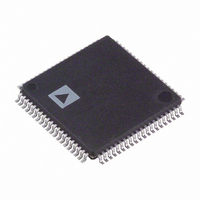ADV7188BSTZ Analog Devices Inc, ADV7188BSTZ Datasheet - Page 39

ADV7188BSTZ
Manufacturer Part Number
ADV7188BSTZ
Description
IC DECODER VID MULTIFORM 80LQFP
Manufacturer
Analog Devices Inc
Type
Video Decoderr
Datasheet
1.ADV7188BSTZ.pdf
(112 pages)
Specifications of ADV7188BSTZ
Applications
Set-Top Boxes, Video Players, Recorders
Voltage - Supply, Analog
3.15 V ~ 3.45 V
Voltage - Supply, Digital
1.65 V ~ 2 V
Mounting Type
Surface Mount
Package / Case
80-LQFP
Resolution (bits)
12bit
Input Format
Analog
Output Format
Digital
Adc Sample Rate
54MSPS
No. Of Input Channels
12
Supply Voltage Range
3V To 3.6V
Lead Free Status / RoHS Status
Lead free / RoHS Compliant
Lead Free Status / RoHS Status
Lead free / RoHS Compliant, Lead free / RoHS Compliant
Available stocks
Company
Part Number
Manufacturer
Quantity
Price
Company:
Part Number:
ADV7188BSTZ
Manufacturer:
Analog Devices Inc
Quantity:
10 000
CHROMA TRANSIENT IMPROVEMENT (CTI)
The signal bandwidth allocated for chroma is typically much
smaller than that of luminance. With older devices, this was a
valid way to fit a color video signal into a given overall band-
width because the human eye is less sensitive to chrominance
than to luminance.
The uneven bandwidth, however, may lead to visual artifacts
during sharp color transitions. At the border of two bars of
color, both components (luma and chroma) change at the same
time (see Figure 22).
Due to the higher bandwidth, the signal transition of the luma
component is usually much sharper than that of the chroma
component. The color edge is not sharp and can be blurred, in
the worst case, over several pixels.
DEMODULATED
To correct for such uneven bandwidths, the CTI block examines
the input video data. It detects transitions of chroma and can be
programmed to create steeper chroma edges in an attempt to
artificially restore lost color bandwidth. By operating only on
edges that are greater than a certain threshold, the CTI block
ensures that noise is not emphasized. Care has also been taken to
avoid edge ringing and undesirable saturation and hue distortion.
Chroma transient improvements are needed primarily for signals
that have severe chroma bandwidth limitations. For these types
of signals, it is strongly recommended to enable the CTI block
via CTI_EN.
CTI_EN, Chroma Transient Improvement Enable,
Address 0x4D [0]
0—Disables the CTI block.
1 (default)—Enables the CTI block.
CTI_AB_EN, Chroma Transient Improvement
Alpha Blend Enable, Address 0x4D [1]
This bit enables an alpha-blend function, which mixes the
transient improved chroma with the original signal. The
sharpness of the alpha blending can be configured via the
CTI_AB [1:0] bits. For the alpha blender to be active, the CTI
CHROMA
SIGNAL
SIGNAL
LUMA
Figure 22. CTI Luma/Chroma Transition
SHARPENED CHROMA
TRANSITION AT THE
OUTPUT OF CTI
LUMA SIGNAL WITH A
TRANSITION, ACCOMPANIED
BY A CHROMA TRANSITION
ORIGINAL SLOW CHROMA
TRANSITION PRIOR TO CTI
Rev. A | Page 39 of 112
block must be enabled via the CTI_EN bit. The settings of the
CTI_AB_EN bit are as follows:
0—Disables the CTI alpha blender.
1 (default)—Enables the CTI alpha blender.
CTI_AB [1:0], Chroma Transient Improvement Alpha
Blend, Address 0x4D [3:2]
The CTI_AB [1:0] controls the behavior of alpha-blend
circuitry, which mixes the sharpened chroma signal with the
original one. It thereby controls the visual impact of CTI on the
output data.
For CTI_AB [1:0] to become active, the CTI block must be
enabled via the CTI_EN bit and the alpha blender must be
switched on via CTI_AB_EN.
Sharp blending maximizes the effect of CTI on the picture, but
may also increase the visual impact of small amplitude, high
frequency chroma noise.
Table 49. CTI_AB [1:0] Function
CTI_AB [1:0]
00
01
10
11 (default)
CTI_C_TH [7:0], CTI Chroma Threshold,
Address 0x4E [7:0]
The CTI_C_TH [7:0] value is an unsigned, 8-bit number speci-
fying how big the amplitude step in a chroma transition must be
to be steepened by the CTI block. Programming a small value
into this register causes even, small edges to be steepened by the
CTI block. Making CTI_C_TH [7:0] a large value causes the
block to only improve large transitions.
The default value for CTI_C_TH [7:0] is 0x08, indicating the
threshold for the chroma edges prior to CTI.
DIGITAL NOISE REDUCTION (DNR) AND
LUMA PEAKING FILTER
DNR is based on the assumption that high frequency signals with
low amplitude are probably noise and that their removal therefore
improves picture quality. There are two DNR blocks in the
ADV7188: the DNR1 block before the luma peaking filter and the
DNR2 block after the luma peaking filter, as shown in Figure 23.
SIGNAL
LUMA
Figure 23. DNR and Peaking Block Diagram
DNR1
Description
Sharpest mixing
Sharp mixing
Smooth mixing
Smoothest mixing
LUMA PEAKING
FILTER
DNR2
ADV7188
LUMA
OUTPUT













